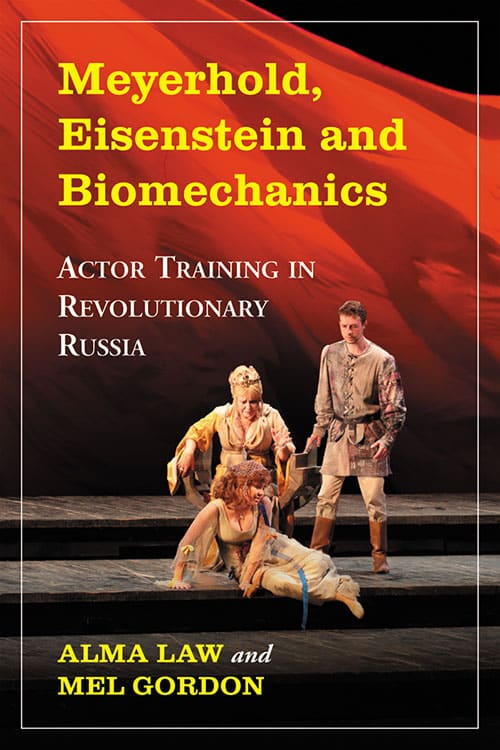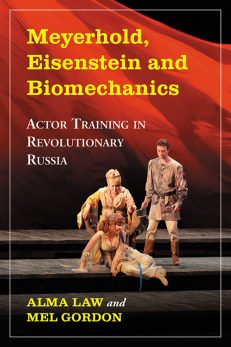Meyerhold, Eisenstein and Biomechanics
Actor Training in Revolutionary Russia
$25.00
In stock
About the Book
Russian theater director Vsevolod Meyerhold designed Biomechanics—a system of actor training—shortly after the Russian Revolution. Although not always understood, it received wide attention as a result of Meyerhold’s unique position as the foremost Soviet avant-garde director. Meyerhold had students that both perfected and challenged his theories in actor training—including the film director Sergei Eisenstein.
Gathered from private Moscow archives, this is the first book-length study of Meyerhold’s stylized training method in practical detail, as well as Eisenstein’s theoretical analysis of Biomechanics. The book traces the history and theoretical foundations of Biomechanics and Expressive Movement, with descriptions of the basic biomechanical exercises and etudes. It also includes a glossary of biomechanical terminology and bibliographical information.
About the Author(s)
Bibliographic Details
Alma Law and Mel Gordon
Format: softcover (6 x 9)
Pages: 294
Bibliographic Info: 40 photos, appendices, glossary, notes, bibliography, index
Copyright Date: 2012 [1996]
pISBN: 978-0-7864-6750-1
eISBN: 978-1-4766-3264-3
Imprint: McFarland
Table of Contents
Acknowledgments ix
Introduction 1
Part I. Meyerhold and Eisenstein
1. Meyerhold: From Actor to Revolutionary Director 13
2. Meyerhold: From Biomechanics to the Triumph of Socialist Realism 33
3. Eisenstein: From Engineer to Revolutionary Filmmaker 74
Part II. Biomechanics
4. Introduction 95
5. Biomechanical Exercises 99
6. Description of the Exercises 106
7. Program of Studies 124
Part III. Documents
8. Meyerhold on Biomechanics 131
Biomechanics of Vsevolod Meyerhold by M. Korenev 133
The Biomechanical Laboratory by M. Korenev 134
Principles of Biomechanics by M. Korenev 135
Meyerhold Demonstrates a Biomechanical Exercise by Erast Garin 139
The Actor of the Future and Biomechanicr by V.-Es. 141
Biomechanics According to Meyerhold by Ippolit Sokolov 144
Taylorism on the Stage by Arkady Pozdnev 148
Project: Profile of the Actor Graduating from the Meyerhold State Theatre School 151
Promptbook for “The Magnanimous Cuckhold” 160
9. Eisenstein on Biomechanics and Expressive Movement 163
Notes on Biomechanics by Sergei Eisenstein 167
Principles of Movement in Our Theatre by Sergei Eisenstein 167
What Is a “Raccourci” and What Is a Pose? by Sergei Eisenstein 168
At Rehearsals of “The Wiseman” by Aleksandr Levshin 170
Expressive Movement by Sergei Eisenstein and Sergei Tretyakov 173
On Recoil Movement by Sergei Eisenstein 192
Lecture on Biomechanics, March 29, 1935, by Sergei Eisenstein 204
10. International Accounts of Biomechanics 224
An Interview with Meyerhold at the Theatre of the Revolution by Lancelot Lawton 225
How Meyerhold Trains his Actors by John Martin 228
Biomechanics in Meyerhold’s Theatre by André Van Gyseghem 233
Notes on Biomechanics by Lee Strasberg 236
Notes on Eisenstein’s Lectures, 1934, by Marie Seton 238
A Biomechanical Session by Harold Clurman 252
Part IV. Appendices
Glossary of Biomechanical Terminology 257
Notes 259
Selected Bibliography 273
Index 275
Book Reviews & Awards
- “Useful…a helpful sourcebook”—Choice
- “The subject of this book is of enormous importance to an understanding of twentieth century Russian and Soviet art, culture and especially theatre…the book will be welcomed by both theatre scholars and practitioners, and especially by those who wish to go beyond the usual actor training syllabus, and engage with something which will challenge and stimulate in equal measure”—Revolutionary Russia
- “This is a sourcebook which gathers a wide range of previously unavailable material…Law and Gordon’s analysis will make a significant contribution to the ongoing process of re-evaluating the role of Biomechanics in the past as well as in the future”—Theatre Research International
- “This panorama illustrates the lasting relationship between Eisenstein and Meyerhold”—International Theatre Informations





